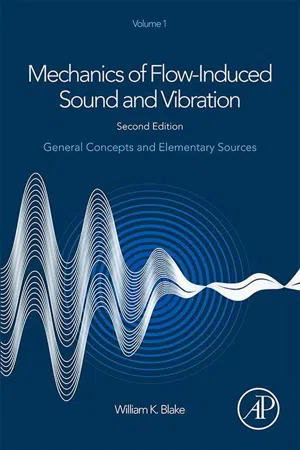
Mechanics of Flow-Induced Sound and Vibration, Volume 1
General Concepts and Elementary Sources
- 502 pages
- English
- ePUB (mobile friendly)
- Available on iOS & Android
Mechanics of Flow-Induced Sound and Vibration, Volume 1
General Concepts and Elementary Sources
About this book
Mechanics of Flow-Induced Sound and Vibration, Volume 1: General Concepts and Elementary Sources, Second Edition, enables readers to fully understand flow-induced vibration and sound, unifying the disciplines of fluid dynamics, structural dynamics, vibration, acoustics, and statistics in order to classify and examine each of the leading sources of vibration and sound induced by various types of fluid motion.Starting with classical theories of aeroacoustics and hydroacoustics, a formalism of integral solutions valid for sources near boundaries is developed and then broadened to address different source types, including jet noise, flow tones, dipole sound from cylinders, and cavitation noise. Step-by-step derivations clearly identify any assumptions made throughout. Each chapter is illustrated with comparisons of leading formulas and measured data.Along with its companion, Mechanics of Flow-Induced Sound and Vibration, Volume 2: Complex Flow-Structure Interactions, the book covers everything an engineer needs to understand flow-induced sound and vibration. This book will be essential reading for postgraduate students, and for engineers and researchers with an interest in aerospace, ships and submarines, offshore structures, construction, and ventilation.- Presents every important topic in flow-induced sound and vibration- Covers all aspects of the topics addressed, from fundamental theory, to the analytical formulas used in practice- Provides the building blocks of computer modeling for flow-induced sound and vibration
Frequently asked questions
- Essential is ideal for learners and professionals who enjoy exploring a wide range of subjects. Access the Essential Library with 800,000+ trusted titles and best-sellers across business, personal growth, and the humanities. Includes unlimited reading time and Standard Read Aloud voice.
- Complete: Perfect for advanced learners and researchers needing full, unrestricted access. Unlock 1.4M+ books across hundreds of subjects, including academic and specialized titles. The Complete Plan also includes advanced features like Premium Read Aloud and Research Assistant.
Please note we cannot support devices running on iOS 13 and Android 7 or earlier. Learn more about using the app.
Information
Introductory Concepts
Abstract
Keywords
1.1 Occ...
Table of contents
- Cover image
- Title page
- Table of Contents
- Copyright
- Dedication
- Preface to the Second Edition
- Preface to the First Edition
- List of Symbols
- Chapter 1. Introductory Concepts
- Chapter 2. Theory of Sound and its Generation by Flow
- Chapter 3. Shear Layer Instabilities, Flow Tones, and Jet Noise
- Chapter 4. Dipole Sound From Cylinders
- Chapter 5. Fundamentals of Flow-Induced Vibration and Noise
- Chapter 6. Introduction to Bubble Dynamics and Cavitation
- Index